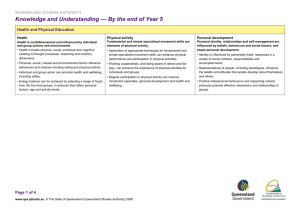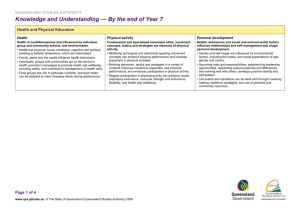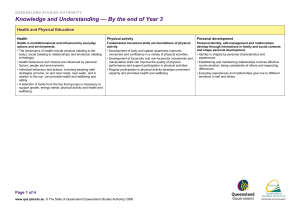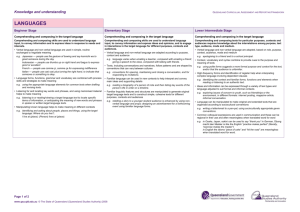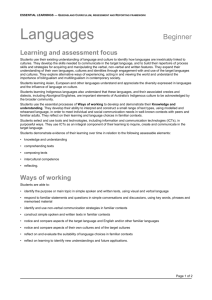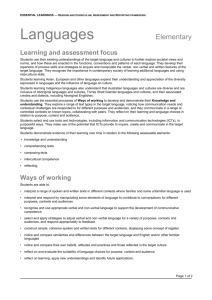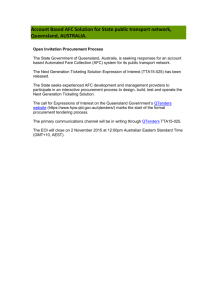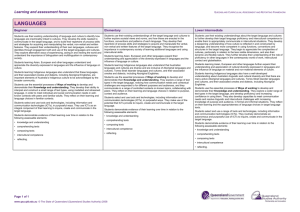DOCX, 53 kB
advertisement
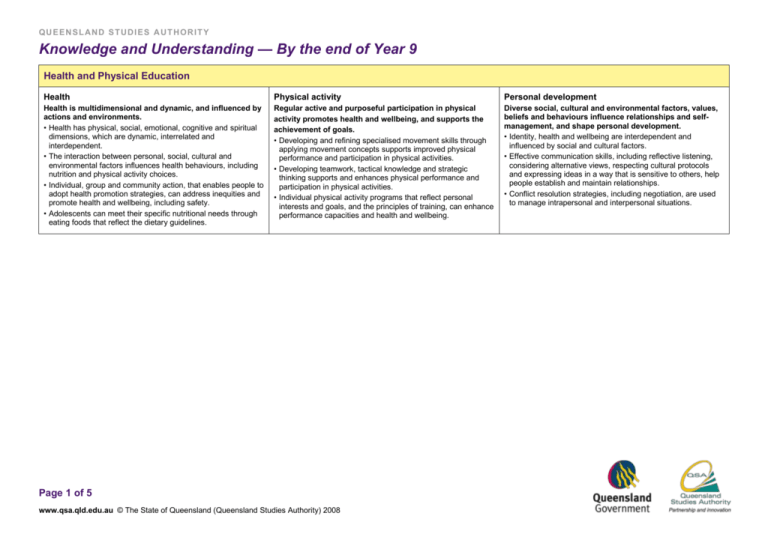
QUEENSLAND STUDIES AUTHORITY Knowledge and Understanding — By the end of Year 9 Health and Physical Education Health Physical activity Personal development Health is multidimensional and dynamic, and influenced by actions and environments. • Health has physical, social, emotional, cognitive and spiritual dimensions, which are dynamic, interrelated and interdependent. • The interaction between personal, social, cultural and environmental factors influences health behaviours, including nutrition and physical activity choices. • Individual, group and community action, that enables people to adopt health promotion strategies, can address inequities and promote health and wellbeing, including safety. • Adolescents can meet their specific nutritional needs through eating foods that reflect the dietary guidelines. Regular active and purposeful participation in physical activity promotes health and wellbeing, and supports the achievement of goals. • Developing and refining specialised movement skills through applying movement concepts supports improved physical performance and participation in physical activities. • Developing teamwork, tactical knowledge and strategic thinking supports and enhances physical performance and participation in physical activities. • Individual physical activity programs that reflect personal interests and goals, and the principles of training, can enhance performance capacities and health and wellbeing. Diverse social, cultural and environmental factors, values, beliefs and behaviours influence relationships and selfmanagement, and shape personal development. • Identity, health and wellbeing are interdependent and influenced by social and cultural factors. • Effective communication skills, including reflective listening, considering alternative views, respecting cultural protocols and expressing ideas in a way that is sensitive to others, help people establish and maintain relationships. • Conflict resolution strategies, including negotiation, are used to manage intrapersonal and interpersonal situations. Page 1 of 5 www.qsa.qld.edu.au © The State of Queensland (Queensland Studies Authority) 2008 QUEENSLAND STUDIES AUTHORITY Knowledge and Understanding — By the end of Year 9 Languages Beginner Elementary Lower Intermediate Comprehending and composing in the target language Comprehending and composing in the target language Comprehending and composing in the target language Comprehending and composing skills are used to understand language input, to convey information and to express ideas in response to needs and interests. • Verbal language and non-verbal language are used in simple, routine exchanges to negotiate meaning. • Language forms, functions, grammar and vocabulary are combined with process skills and strategies to make meaning. • Listening for and locating key words and phrases, and using memorised material helps to make meaning. • Manipulating known language helps to make meaning in different contexts. Comprehending and composing skills are used to understand language input, to convey information and express ideas and opinions, and to engage in interactions in the target language for different purposes, contexts and audiences. • Verbal language and non-verbal language are adapted according to purpose, context and audience. • Texts, including conversations and narratives, follow patterns and are shaped by conventions that can vary between cultures. • Familiar language can be used in new contexts to help interpret and convey main ideas and supporting details. • Familiar linguistic features and structures are manipulated to generate original target language texts and to construct simple, cohesive texts for different purposes, contexts and audiences. Comprehending and composing texts for particular purposes, contexts and audiences requires knowledge about the interrelations among purpose, text type, audience, mode and medium. • Verbal language and non-verbal language are adapted, based on role, purpose, context, audience, mode and medium. • Context, vocabulary and syntax combine to provide cues to the purpose and meaning of texts. • High-frequency forms and identification of register help when interpreting complex language involving dependent clauses. • Ideas and information can be expressed through a variety of text types and language adjusted to suit formal and informal contexts. • Language can be manipulated to make original and extended texts that are organised according to sociocultural conventions. • Common colloquial expressions are used in communication and these can be regional in their use and often meaningless when translated word for word. Intercultural competence and language awareness Noticing and comparing similarities and differences between languages and cultures informs intercultural communication. • Learning languages provides insights into one’s own languages and the target language, and how concepts are expressed across languages. • Ways of using language provide information about cultures. • Languages and cultural practices have particular features, conventions, patterns and practices that may be similar to or different from one’s own language and culture. Intercultural competence and language awareness Intercultural competence and knowledge of languages and cultures allow for exploration of different ways of experiencing and acting in the world. • Ideas or information may or may not be transferable from one language to another and can provide cultural insights and information. • Cultural practices in the target language can be compared with those of other cultures and connections noticed between language use and cultural knowledge and behaviour. • Investigations into language use and cultural beliefs, attitudes and practices further develop intercultural competence. Page 2 of 5 www.qsa.qld.edu.au © The State of Queensland (Queensland Studies Authority) 2008 Intercultural competence and language awareness Intercultural competence and knowledge of languages and cultures allow for differing ways of experiencing, acting in and viewing the world. • Regional and social diversity exists within and across languages and cultures, and this diversity informs appropriate communication. • Familiarity with issues and topics of significance to members of the target culture enhances intercultural communication. • Beliefs, values and attitudes are embedded in languages and cultures; and knowledge of these aspects can facilitate intercultural communication. QUEENSLAND STUDIES AUTHORITY Knowledge and Understanding — By the end of Year 9 Studies of Society & Environment Time, continuity and change Place and space Culture and identity Political and economic systems Social, political, economic and cultural changes and continuities are connected to particular events, ideas and contributions, and can be interpreted from different perspectives. • Australian narratives and identities have been shaped by 20th century events including major conflicts, waves of immigration, social divisions and changes, and government relations with other nations. • Important ideas of democracy, government and law, citizenship rights and public decision making, and the concepts of power, dissent and civic duty, developed from ancient to modern times and from Eastern and Western cultures. • Evidence of events in Australian, Asian, Pacific and global settings can be interpreted from different perspectives and values positions. Environments are defined by spatial patterns, human and physical interactions, and sustainable practices can balance human activity and environmental processes. • Australia, the Asia–Pacific region and other global settings are defined by a range of natural characteristics and processes, including landforms, vegetation and climatic zones, and human activities, including cultural, economic and political activity. • Interrelationships between human activity and environments result in particular patterns of land and resource use, and can cause environmental problems. • Governments and communities need to balance economic, social, political and environmental factors through sustainable development, consumption and production. • Physical environments are defined by spatial patterns, including the arrangement of elements on the Earth’s surface, the definable areas of the Earth’s surface, the space between different locations, and absolute and relative location. • Maps, including topographic, political and thematic maps, are developed with particular features, including scale, contour lines and human-created boundaries, and use the specific skills of observing, visualising, estimating, sketching and measuring. Cultures and identities are shaped by a range of factors, and societies promote cohesion and diversity in different ways. • Group identities are influenced by different factors, including family, communities, nationality, socioeconomic factors and religious beliefs. • Cultural diversity in Australia is influenced by public opinion, media portrayals, government policies and the impacts of globalisation. • Community perceptions of Aboriginal cultures and Torres Strait Islander cultures have resulted in positive and negative responses to Indigenous people. • Contact between cultures has produced movements to improve democratic participation and citizenship rights for specific groups. • Cultural research involves following protocols and acting sensitively. Societies consist of interconnected decision-making systems, institutions and processes based on principles and values. • Australia’s government systems are based on liberal democratic principles, including the “common good” and parliamentary elections, perform functions, including developing policy and formulating legislation, and have institutions and instruments, including the High Court and Acts of Parliament. • Australia’s legal and justice systems are based on principles, including an independent judiciary, perform functions, including the protection of rights, and use different types of law and courts. • Australian citizenship involves recognising global perspectives and balancing majority rule against respecting minority interests. • Australia’s relationships with other nations involve membership of international organisations and participation in global systems of law, diplomacy, human rights, trade and security. • Australia’s economic system is shaped by a range of economic activities, including production and consumption, and government regulation. Page 3 of 5 www.qsa.qld.edu.au © The State of Queensland (Queensland Studies Authority) 2008 QUEENSLAND STUDIES AUTHORITY Knowledge and Understanding — By the end of Year 9 Technology Technology as a human endeavour Information, materials and systems (resources) Technology influences and impacts on people, their communities and environments in local and global contexts. • New products and technologies are designed and developed to meet changing needs and wants of intended audiences, and include artefacts, systems, environments, services and processes. • Product design and production decisions are influenced by aspects of appropriateness and by detailed specifications, constraints and standards of production. • People can influence decisions made about the design, development and use of technology to change the impact on people, their communities and environments at local and global levels. Resources originate from different sources, exist in various forms and are manipulated to meet specifications and standards to make products. • Characteristics of resources are compared, contrasted and selected to meet detailed specifications and predetermined standards of production to best suit the user. • Techniques and tools are selected, controlled and managed to manipulate or process resources to meet detailed specifications and predetermined standards of production. Page 4 of 5 www.qsa.qld.edu.au © The State of Queensland (Queensland Studies Authority) 2008 QUEENSLAND STUDIES AUTHORITY Knowledge and Understanding — By the end of Year 9 The Arts Dance Drama Media Music Visual Art Dance involves using the human body to express ideas, considering specific audiences and specific purposes, by manipulating dance elements in genre-specific dance sequences. • Genre-specific movements are used to create actions for dance sequences. • Traditional and non-traditional performance areas are used to manipulate movement in space. • Irregular and mixed metres are used to manipulate timing. • Combinations of movement qualities are used to manipulate energy. • Structuring devices, including embellishment, abstraction and variation forms, are used to organise movement. Drama involves manipulating dramatic elements and conventions to express ideas, considering specific audiences and specific purposes, through dramatic action based on real or imagined events. • Roles, characters and relationships are interpreted to define motivation and purpose, using specific vocal and physical techniques. • Drama elements are manipulated to create tension and status, and are used to express ideas. • Dramatic action and texts are created and interpreted through specific styles, including realism and non-realism. Media involves constructing meaning, considering specific audiences and specific purposes, by manipulating media languages and technologies to shape representations. • Still and moving images, sounds and words are used to construct and reconstruct meaning in media texts. • Media techniques and practices are used to market, promote, deliver and exhibit media texts. • Representations of different beliefs and ideas in media texts are influenced by regulations and by contexts of audiences, producers and institutions. Music involves singing, playing instruments, listening, moving, improvising and composing by manipulating the music elements to express ideas, considering specific audiences and specific purposes, through sound. • Duration, beat, time values and metre are used to create and vary rhythm. • Pitch, tonalities, scales and intervals are used to create and vary the horizontal arrangement of sound. • Tonalities and harmonies are used to organise music in different vertical arrangements. • Contemporary, traditional and genre-specific musical forms are used to structure music. • Interaction between the linear and the vertical arrangement of music is used to create the texture or density of sound. • Vocal, instrumental, electronic and computer-generated sound sources have characteristic sound qualities (tone colour) that can be altered through methods of production and manipulation. • Relative softness and loudness of sounds, and digital and electronic devices, are used to change dynamic levels and expression of music. Visual Art involves manipulating visual arts elements, concepts, processes and forms (both 2D and 3D) to express ideas, considering specific audiences and specific purposes, through images and objects. • Ideas are researched to inform visual responses that consider social and cultural issues. • Design and visual documentation are used to develop images and objects from visual, verbal and tactile stimuli. • Media areas are used in isolation and in combination to make arts works. • Visual arts elements and concepts in combination are used to create compositions. Page 5 of 5 www.qsa.qld.edu.au © The State of Queensland (Queensland Studies Authority) 2008
